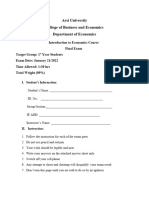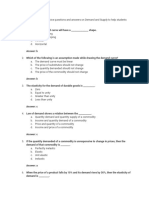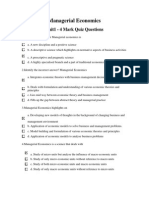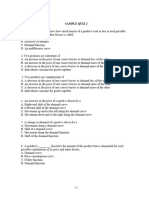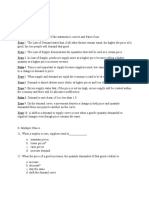0 ratings0% found this document useful (0 votes)
91 viewsMara Lavin - Topic 003 Tutorial Questions - Consumer Decision
This document contains a tutorial on consumer demand concepts from economics including:
- True/false and multiple choice questions covering topics like total utility, marginal utility, law of diminishing marginal utility, price elasticity, and determinants of demand.
- Sample utility schedule to calculate marginal utility and total utility at different consumption levels.
- Questions assess understanding of key demand and utility concepts as well as elasticity including perfect inelastic, unitary, and elastic curves.
Uploaded by
Lee XingCopyright
© © All Rights Reserved
Available Formats
Download as DOCX, PDF, TXT or read online on Scribd
0 ratings0% found this document useful (0 votes)
91 viewsMara Lavin - Topic 003 Tutorial Questions - Consumer Decision
This document contains a tutorial on consumer demand concepts from economics including:
- True/false and multiple choice questions covering topics like total utility, marginal utility, law of diminishing marginal utility, price elasticity, and determinants of demand.
- Sample utility schedule to calculate marginal utility and total utility at different consumption levels.
- Questions assess understanding of key demand and utility concepts as well as elasticity including perfect inelastic, unitary, and elastic curves.
Uploaded by
Lee XingCopyright
© © All Rights Reserved
Available Formats
Download as DOCX, PDF, TXT or read online on Scribd
You are on page 1/ 3
ECO 105 TUTORIAL QUESTIONS Mara Lavin
Topic 3: Consumer Demand (Chapter 4, Ref. A)
TRUE OR FALSE
1. Total utility is the additional satisfaction received from consuming one more unit. F
2. The price elasticity of demand measures the response of consumers to a change in price. T
3. The demand is price-inelastic when the percentage change in quantity demanded is greater than the
percentage change in price for a particular good. F
4. Ceteris paribus, a price cut will most likely decrease total revenue if demand is inelastic. T
5. Ceteris paribus, the price elasticity of demand for a good with many substitutes is likely to be inelastic. F
MUTIPLE CHOICE
1. Which of the following is not a determinant of demand for a good?
A. Tastes or preferences.
B. Income.
C. Prices of other goods.
D. Technological advances.
2. In economic theory, utility refers to the:
A. Additional satisfaction obtained from one more unit of a good or service.
B. Satisfaction obtained from a good or service.
C. Willingness to buy specific quantities of a good or service at a particular price.
D. Decrease in satisfaction as more of a good or service is consumed.
3. Which of the following refers to the satisfaction a consumer receives from the consumption of a good?
A. Price elasticity.
B. Law of demand.
C. Equilibrium price.
D. Utility.
4. In economic theory, total utility refers to:
A. The additional utility from consuming the last unit of a good.
B. The amount of utility obtained from the entire consumption of a good.
C. The change in utility from the last unit sold.
D. How useful a good is to the consumer.
5. Marginal utility refers to the:
A. Additional utility from consuming the last unit of a good.
B. Change in utility from the last unit consumed.
C. Utility derived from consuming all of the good.
D. Opportunity cost of the good.
6. According to the law of diminishing marginal utility:
A. Total utility from consuming a good always rises.
B. Total utility from consuming one more unit of a good eventually falls.
C. Marginal utility of a good declines as more of it is consumed in a given time period.
D. Marginal product of labor declines as more of a variable input is used.
7. The law of diminishing marginal utility helps to explain the:
A. Upward sloping supply curve.
B. Equilibrium price.
C. Downward sloping demand curve.
D. Equilibrium quantity of a good in the marketplace.
8. In economics, elasticity means ______.
A. responsiveness
Tutorials – Principles of Economics 1
B. satisfaction
C. output
D. pleasure
9. The response of quantity demanded to price changes is shown by:
A. Price elasticity of demand.
B. The determinants of demand.
C. Opportunity cost.
D. Income elasticity of demand.
10. Price elasticity of demand indicates the consumer’s response to changes in:
A. Quantity.
B. Demand.
C. Price.
D. Supply.
11. Which of the following are determinants of price elasticity?
A. The availability of substitutes.
B. The price of the good relative to income.
C. Whether the good is a necessity or luxury.
D. All of the above are determinants of price elasticity.
12. The price elasticity of demand is defined as the:
A. Percentage change in quantity demanded times the percentage change in price.
B. Unit change in price divided by the unit change in quantity demanded.
C. Percentage change in quantity demanded divided by the percentage change in price.
D. Unit change in quantity demanded times the unit change in price.
13. Suppose the price elasticity of demand for tacos is 0.80. If the price of tacos increases by 10
percent, then the quantity demanded of tacos should, ceteris paribus:
A. Decrease by 8 percent.
B. Increase by 8 percent.
C. Decrease by 1.25 percent.
D. Increase by 1.25 percent.
14. If the price elasticity of demand for a product is 2.3, this means that quantity demanded will
increase by _______ for each _______ decrease in price, ceteris paribus.
A. 1 percent; 2.3 percent
B. 1 unit; $2.30
C. 2.3 percent; 1 percent
D. 2.3 units; $1
15. If the price elasticity of demand is 1.5, and the prices gone up by 20 percent, the quantity sold will, ceteris paribus:
A. Rise by 13.3 percent.
B. Fall by 13.3 percent.
C. Rise by 30.0 percent.
D. Fall by 30.0 percent.
16. If demand is elastic, then:
A. Quantity demanded is not very responsive to changes in price.
B. Quantity demanded is very responsive to changes in price.
C. Consumer spending does not respond to changes in income.
D. Total revenue falls in response to a price decrease.
17. If demand is inelastic, then:
A. Consumer spending does not respond to changes in income.
B. Total revenue rises in response to a price decrease.
C. Quantity demanded is very responsive to changes in price.
D. Quantity demanded is not very responsive to changes in price.
18. If quantity demanded rises only slightly following a moderate price cut, then demand is:
A. Elastic.
Tutorials – Principles of Economics 2
B. Inelastic.
C. Unitary elastic.
D. Abnormal.
19. If demand is unitary elastic, then a price cut:
A. Reduces total revenue.
B. Increases total revenue.
C. Does not change total revenue.
D. Sometimes increases and sometimes decreases total revenue.
20. Ceteris paribus, a price increase will cause total revenue to decrease for a firm, if the demand for its product is:
A. Inelastic.
B. Elastic.
C. Unitary elastic.
D. Normal elastic.
21. Ceteris paribus, a price decrease will cause total revenue to decrease for a firm, if the demand for its product is:
A. Unitary elastic.
B. Inelastic.
C. Elastic.
D. Increasing rapidly.
22. People find it difficult to get along without necessities, therefore demand for necessities:
A. Is relatively elastic.
B. Is relatively inelastic.
C. Is relatively unitary elastic.
D. Does not change with changes in price.
23. Table 4.1 - Utility schedule
Complete the table and then use the information to answer the question(s) below
In Table 4.1, the marginal utility of the third unit is:
A. 5
B. 8
C. 12
D. 52
In Table 4.1, the total utility when four units are consumed is:
A. 57
B. 52
C. 8
D. 5
Tutorials – Principles of Economics 3
You might also like
- Economics for CFA 2024: level 1 in just one week: CFA level 1, #4From EverandEconomics for CFA 2024: level 1 in just one week: CFA level 1, #44.5/5 (2)
- Answers To End of Chapter Questions: International Financial Management100% (1)Answers To End of Chapter Questions: International Financial Management6 pages
- Multiple Choice Tutorial: Demand, Supply and Markets100% (1)Multiple Choice Tutorial: Demand, Supply and Markets62 pages
- ECO 100 Quiz 1 02 2020 Your Name Your Student NumberNo ratings yetECO 100 Quiz 1 02 2020 Your Name Your Student Number12 pages
- Question Bank of Managerial Economics - 4 Mark100% (4)Question Bank of Managerial Economics - 4 Mark23 pages
- Economy Today 14th Edition Schiller Test Bank 1100% (50)Economy Today 14th Edition Schiller Test Bank 136 pages
- Chapter Twenty: Elasticity of Demand and SupplyNo ratings yetChapter Twenty: Elasticity of Demand and Supply5 pages
- Final Model Questions Based on Bloom TaxonomyNo ratings yetFinal Model Questions Based on Bloom Taxonomy33 pages
- Economic Analysis For Business Decisions MCQ&A-1No ratings yetEconomic Analysis For Business Decisions MCQ&A-122 pages
- KH Tax Guide To Taxation in Cambodia 2020No ratings yetKH Tax Guide To Taxation in Cambodia 202030 pages
- Cambodian 2018 Tax Booklet: A Summary of Cambodian TaxationNo ratings yetCambodian 2018 Tax Booklet: A Summary of Cambodian Taxation26 pages
- Homework Chapter 2: BE 3-4 Larned Corporation Recorded The Following Transactions For The Past Month100% (1)Homework Chapter 2: BE 3-4 Larned Corporation Recorded The Following Transactions For The Past Month3 pages
- Tutorial Sheet 2 Consumer Choice Theory and Production2No ratings yetTutorial Sheet 2 Consumer Choice Theory and Production23 pages
- Marriot Corp. Assignment 1. Vishal Sharma EPGP-14A-135No ratings yetMarriot Corp. Assignment 1. Vishal Sharma EPGP-14A-1356 pages
- Kansai Nerolac Paints Limited: Corporate PresentationNo ratings yetKansai Nerolac Paints Limited: Corporate Presentation42 pages
- Simple and Compound Interest: P (Principle), R (Rate of Interest Per Annum), T (Time)No ratings yetSimple and Compound Interest: P (Principle), R (Rate of Interest Per Annum), T (Time)27 pages
- Krenar HASANAJ - Eduard PLLUMBAJ - Railway Sector - What We Need and What We WantNo ratings yetKrenar HASANAJ - Eduard PLLUMBAJ - Railway Sector - What We Need and What We Want28 pages
- The Political Economy of The Arab Uprisings 1st Edition Melani Cammett All Chapter Instant Download100% (3)The Political Economy of The Arab Uprisings 1st Edition Melani Cammett All Chapter Instant Download80 pages
- Financial Derivatives: Multiple Choice Questions100% (2)Financial Derivatives: Multiple Choice Questions11 pages
- A Critical Study On The Environmental Management of Multinational Corporations in IndiaNo ratings yetA Critical Study On The Environmental Management of Multinational Corporations in India7 pages
- [Ebooks PDF] download Alternative Exchanges Second Hand Circulations from the Sixteenth Century to the Present 1st Edition Laurence Fontaine full chapters100% (19)[Ebooks PDF] download Alternative Exchanges Second Hand Circulations from the Sixteenth Century to the Present 1st Edition Laurence Fontaine full chapters60 pages
- Elwak Rhamu Feasibility Study Report - RevisedNo ratings yetElwak Rhamu Feasibility Study Report - Revised111 pages
- Solar Panel HiKu6 - CS6R-MS - Black - Frame - v1.9W25 - F55 - EN - 395-420WNo ratings yetSolar Panel HiKu6 - CS6R-MS - Black - Frame - v1.9W25 - F55 - EN - 395-420W2 pages











